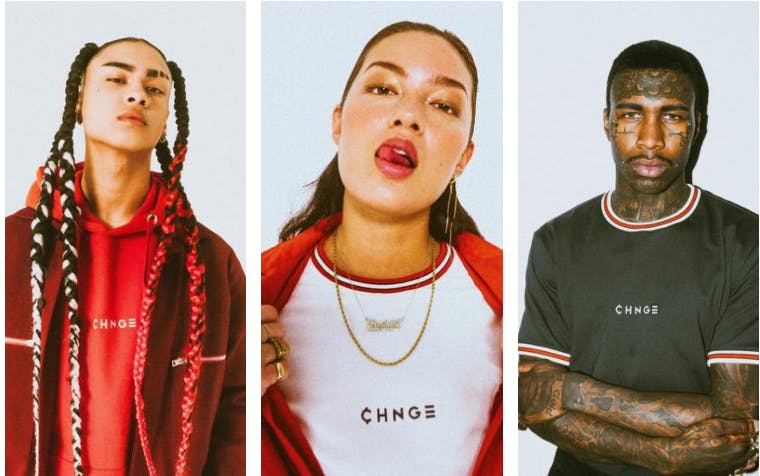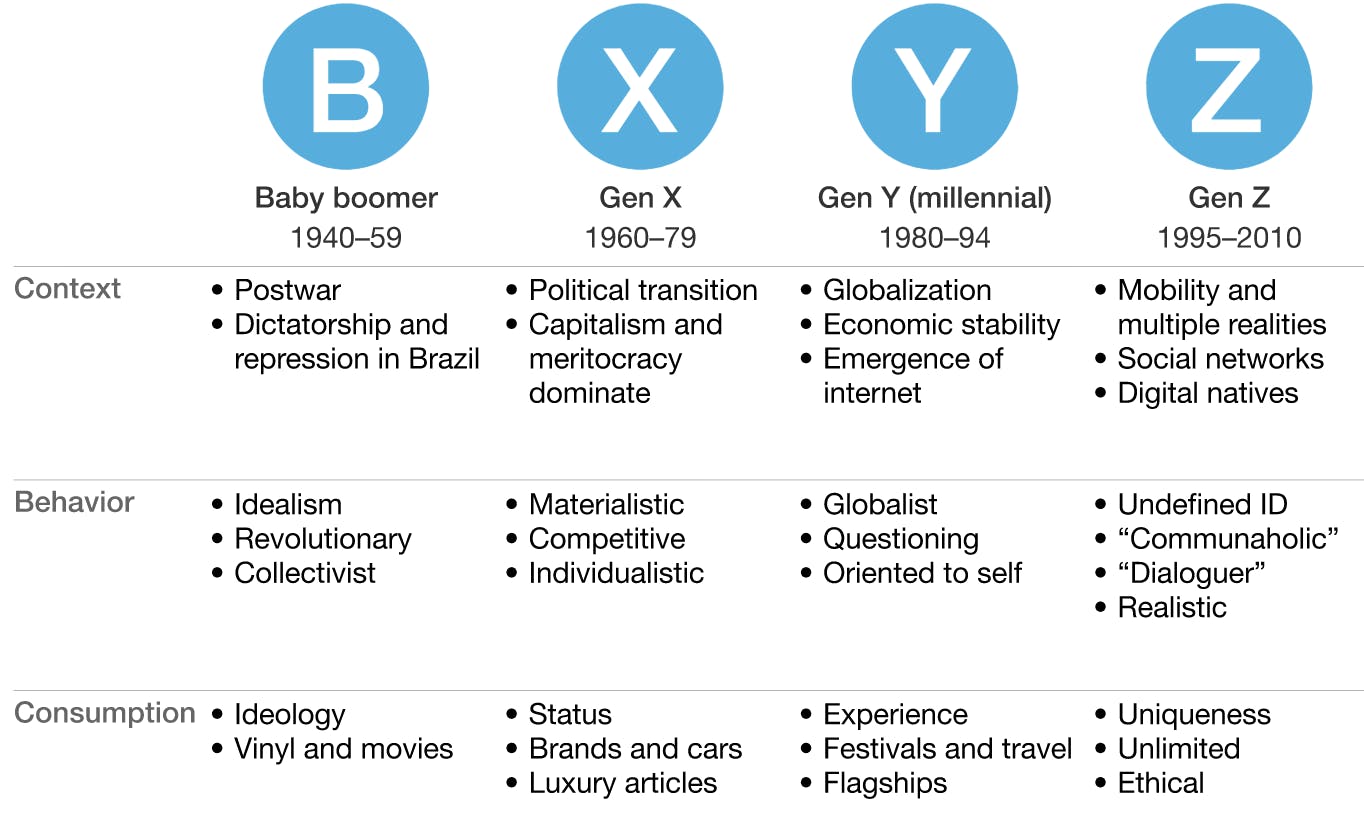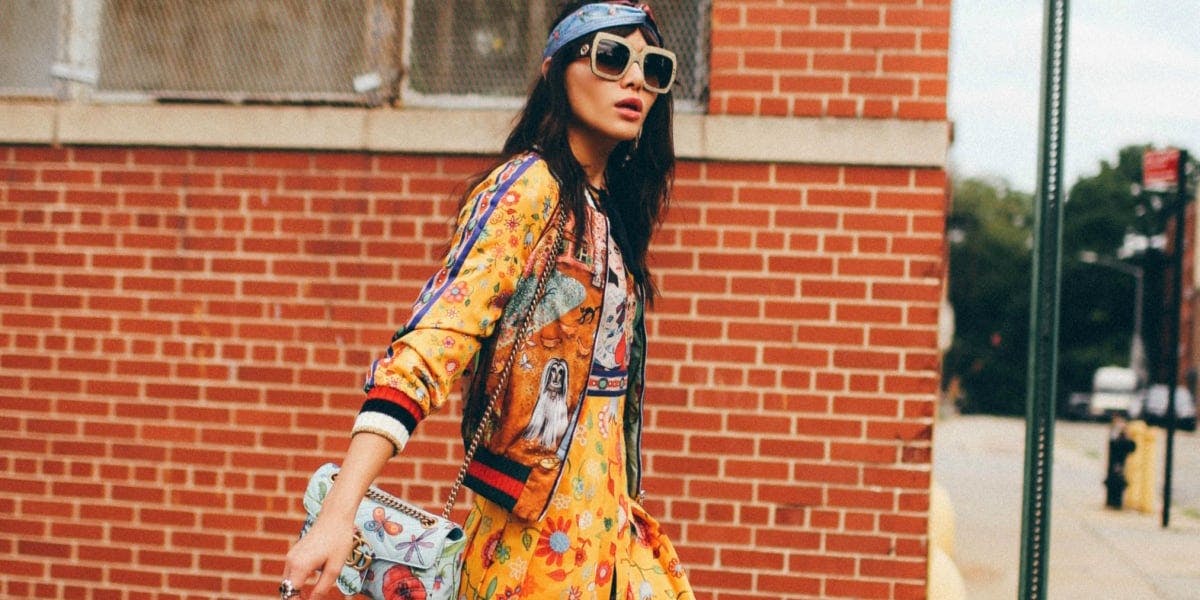The Subtle Art of (Not) Understanding Gen Z

Breaking down the newest generation of consumers
As a kid I used to like summer homework — did I really? Well, I like to think of my young me as a disciplined student with perfect calligraphy after a long summer of practice. Some habits can’t be lost and, this summer around, I spent some time trying to better understand Gen Z.
‘Gen What?’
iGen, Tech Gen, Digital Natives, True Gen, Post-Millenials, Memelords, LitGen, Memennials, Generation Snap, the Hopeful Generation, the Anxious Generation, Generation Fix-It, the Cleaner-Uppers, the Last Generation, the Final Generation — you name it.
"The Sisu Generation" might be one of my faves, but let’s stick to Gen Z.
Gen Z refers to the people born from 1995 to 2010.
I’ve always thought that trying to give common characteristics to a bunch of very different people born in a particular point in time was dumb. However, there are some consumer trends that, on average, are common to certain generations.
Gen Z are true digital natives. From a very young age, they've been exposed to technology and the internet. The only phones they know are smartphones. Remember Nokia 3330? Well, they never had one. Most of them probably didn't even have a BlackBerry. In some cultures, especially in China, mobile is their gateway to find anything they need. This translates to Gen Z being a hypercognitive generation, and therefore the best informed at any age. Collecting and cross-referencing information is their routine, as well as learning surfing the web and watching YouTube.

‘And why are you so interested in Gen Z?’ — some people asked me.
Millennials are so 2015; their priorities are changing and with the majority of them (I mean, us) rounding 30, they're starting to settle down and consume differently.
Younger generations are the new consumers. Gen Z has now entered the job market and their spending power is only increasing. Global Gen Z amounts to 2.4 billion people, representing 32% of the world’s population. Today Gen Z already holds over $44 billion in buying power, according to the National Retail Federation. A different source estimates that, only in the U.S., Gen Z has a direct spending power ranging from $30 billion to $140 billion and an indirect spending power of $600 billion. Today, China’s Gen-Z spends 15% of a household’s income — the highest proportion of any country, especially when compared to some Western countries (such as France at 5% or the UK and the U.S. at 4%).
Brands need to rethink how to serve the new consumers of this not-so-new generation. Marketers should innovate in the ways to reach them and investors must keep in mind the latest consumer trends driven by Gen Z’s new norms. Young people have a tremendous influence on all other generations and in the ways these older people consume.
Access vs. possession, mass production vs. personalisation and individual identity, social responsibility initiatives vs. ethical concerns at the core — companies need to rethink how to deliver value to consumers and transform new challenges into opportunities.
In this article, you’ll find:
- Some common traits of Gen Z-ers
- How brands can reach this generation
- What industries I find particularly interesting in the context of Gen Z-ers as new consumers
- What verticals will see more of the next billion-dollar companies driven by Gen Z’s norms
- A summarized cheat sheet (for those in a rush)

MAC’s collaboration with Brant Brothers on flawless unisex makeup.
Some common traits
Gen Z is probably the most empowered generation to date. They are willing to solve problems themselves rather than hoping for more established institutions to act on them. They have a very entrepreneurial mindset and they are great at problem solving and information gathering. They are genuinely curious and eager to learn, making Gen Z a very well-informed generation (from a very young age). That’s also why they are realistic and live their lives more pragmatically than previous generations. Almost 90% of Gen Z-ers spend part of their free time in activities they consider productive and creative, and almost 80% of them believe they will need to work harder than previous generations to succeed.
They are ambitious and willing to change the world they live in. They have assumed at a young age that they are meant to make things better. That’s what drives them. They often think improvement is more important than discovery, reinvention is better than invention from scratch.
They are very aware of everything happening around them and often feel a strong sense of responsibility. They think ethics and social responsibility should always be at the core (of companies, of people’s actions and daily habits, etc.). 90% of Gen Zers believe companies have a responsibility to address social and environmental issues. Their hyper-cognitivity (mostly driven by their access to information and cross-referencing of different sources) helps them find inconsistencies very quickly in companies’ messages and actual actions. They will always pick up on lack of transparency or behaviors that don’t resonate with Gen Z-ers’ values.
They are often more financially driven and conscious than millennials, which might be explained by the context in which Gen Z-ers have been raised and their exposure during their upbringing to the (post) financial crisis.
However, their empowerment also translates sometimes into what some call a ‘spoiled’ generation — most Gen Z-ers have had everything they wanted very young, and they now work towards their own happiness. They are used to instant gratification and they will not do something they are not genuinely willing to do unless there is a good reason to do so.
Through this need for instant gratification and overflow of information, Gen Z-ers tend to focus in shorter timeframes and typically only for things they are interested in. This generation prefers short forms of everything (short articles vs. detailed papers, quick videos vs. movies, texting vs. calling, etc.). This makes them more impatient, which is reflected in the way they think of trends. What’s "cool" doesn’t last long and trends move very quickly. If companies can’t adapt to this rapidly moving cycle, they can be out of the game.
The high usage of social media has spawned a generation of people who constantly compares themselves to others, potentially leading to self-esteem issues and indecisiveness. As described by Times and a study published in the Journal of Abnormal Psychology, ‘between 2009 and 2017, rates of depression among kids ages 14 to 17 increased by more than 60%, the study found. The increases were nearly as steep among those ages 12 to 13 (47%) and 18 to 21 (46%), and rates roughly doubled among those ages 20 to 21’. Jean Twenge, professor of psychology at San Diego State University and author of iGen, explains that ‘there is an overwhelming amount of data from many different sources, and it all points in the same direction: more mental health issues among American young people’. That might also explain why Gen Z is seeking more unique experiences, including psychedelics to create a different reality.
Uniqueness and exclusivity are key behavioral drivers. Gen Z-ers often build for themselves an online identity that is different from their offline persona. Think of all the filters used in social media, apps to smooth skin and look skinnier, online make-up options, etc. Some online celebrities are real world introverts.
On the flip side, some are more authentic. Gen Z appreciates authenticity and people who show themselves in a more genuine way tend to have a lot more influence. It’s the balance between looking cool and unique, and being authentic and honest that people look for.
And it’s precisely that worship for authenticity that has made fluidity one of the most important common traits among Gen Z-ers. This generation’s communities are built based on common interests and not social backgrounds or demographics. Gen Z doesn’t care about age, race, or sexual orientation. Gender means less to them and they often criticize brands that offer different products based on gender. ‘Fabric is genderless’; ‘believe in being yourself rather than imposing your gender on yourself’. These are some common observations Gen Zers share — ‘it isn’t about fluid gender identity [but] fluid gender behavior’. Expressing individual truth is what matters, and not defining oneself is the only way to do so. This generation is ‘radically inclusive’.
Gen Z often values things over experiences and access over ownership. But they are also well-informed to understand when owning makes more sense than subscribing for access. Trading items is a new form of investing, especially when it comes to fashion.
Finally, Gen Z believes dialogue is the most efficient way to solve conflicts, share ideas, and improve the world. They mobilize themselves often but avoid doing so in a confrontational way.
It is important to note that older Gen Z-ers are quite different from the younger ones today. While they share some common traits, younger Gen Z-ers are still figuring things out (they might care less about values given they don’t yet know their own core ones, for instance). That said, I think younger Gen Z-ers will converge to how the older part of this generation behaves today.
The exhibit below from a report from McKinsey shows different generations’ shared characteristics.

How can brands reach Gen Z consumers?
When it comes to Gen Z, macro- and micro-influencers are over. If anything, nano-influencers might still make sense, but some already talk about ‘anti-influencers’. Gen Z only cares about genuine content. They want it to feel real and authentic. They trust their friends and close circle of good acquaintances. Content creators should only sponsor brands directly related to their true interests. Long-term sponsorships work better than sporadic and random posts. Gen Z-ers won’t trust the latter and mass advertising won’t work on a stand-alone basis.
To connect with Gen Z, niche campaigns and even live events can have a tremendous impact on conversion. Then, a good product and some sense of exclusivity will help with retention. This doesn’t mean brands can’t get big, but mass-production needs to be redesigned.
Think of Supreme, a $1 billion-dollar streetwear company that manages to keep its authenticity with limited product releases and artists collaborations. In-store prices go from ~$40 for a t-shirt to ~$150 for a sweatshirt, but when products sell out, they can be re-sold for 30 times their original price. ‘Supreme, baby!’ as they say.
More popular among older Gen Z-ers (and younger millennials), Supreme is a good example to illustrate the value of exclusivity and uniqueness. Brands need to rethink how to optimize production to reach economies of scale while maintaining singularity. But this doesn’t apply to every category. Gen Z-ers are very pragmatic. They don’t need to use exclusive consumables (like replenishment products, cleaning, grooming, etc.). It’s mostly about the look when exclusivity and uniqueness matter most.
In other categories, brand values are key, putting ethics at the core. A company’s mission becomes more important than ever. Eco-friendly, vegan, plastic free, recyclable, and others are fundamental brand attributes for some categories. Caring for these values might also have an impact on online shopping. People are becoming more aware of the negative environmental footprint of receiving several packages every week for all their subscriptions and online orders (unnecessary extra packaging, carbon footprint of delivery providers, etc.).
But sustainable alone won’t sell. You need to still offer the best product or service at a reasonable price. Brand it well, and be ethical at the core and not to sell the brand. They’ll know if you’re not truthful.
Reaching Gen Z consumers also means understanding how they spend their time. Video is their preferred format for communication and information gathering — it’s the YouTube’s renaissance and the Vlog’s heyday. TikTok is only getting more popular among young people. Instagram is not only a millennial thing and it's still huge, especially thanks to stories. Snap is also in vogue, but not so relevant for marketing purposes. Twitter seems to be back in business, with more Gen Z-ers starting to use it as an additional information source, especially in tech.
Community platforms are key. That’s why Gen Z-ers spend a lot of their time in Twitch, a gaming social platform. Even Fortnite is often referred to as the new Facebook (especially for younger Gen Z-ers). You can often find Gen Z-ers spending time trading clothes in platforms like Depop, learning and building communities on Reddit, or sharing pictures on Imgur. Some also use Lomotif to watch (and show their own) videos and discover music.
Short-form content is king. Gen Z-ers prefer to watch multiple videos of five to 15 minutes rather than one single 30-minute episode. This relates to their shorter attention span and eagerness for concise and practical information. Simpler is better.
Counterintuitively, offline is still a real thing. Even if half of Gen Z-ers are online for 10+ hours a day, almost 70% of them do most of their shopping in a store. Omni-channel strategies are essential to reach them.
What are some of the most exciting industries?
Consumer trends’ changes affect almost every industry. However, there are some that will have a more direct impact from Gen Z-ers new habits sooner. Gaming, beauty, fashion, and food and beverages are some of the most relevant ones.
Gaming: an alternative reality
In 2018, the video game industry was expected to generate $140 billion in revenue, of which ~$30 billion is estimated to come from Gen Z-ers. In the U.S., 90% of teens play video games of some kind. Google gets more than 200 million active users logged-in daily to watch gaming content and YouTube had more than 50 billion watched hours of the same in 2018.
This hypercognitive generation sees gaming as an escape from their stressful lives. Excess of information, social media pressure, and concerns to become successful and fulfilled, make Gen Z-ers need some time off. Gaming helps them relax and often become a different person. It’s a mindful retreat and a productivity enhancer. That’s why about two thirds of Gen Z refer to gaming as their number one hobby, and about a quarter of the top 20 Gen Z influencers are gamers. They see gaming more as collaborative experience rather than a competitive one. Indeed, they also use games as community building.
For instance, when referring to Fortnite (a multi-player video game with 250+ million users), Gen Z-ers describe it as the best place to ‘be my authentic self’ and to ‘connect to what everyone is talking about, making me feel like I’m not alone.’ Fortnite has become very popular on Twitch, where it has the largest audiences and most streamers. According to Twitch data, Fortnite’s live videos and gameplay totaled 100+ million hours last March.
Beauty: an identity builder
The beauty market is giant and growing fast; the market for cosmetics is posed to grow to over $800 billion by 2023, and was valued at over $530 billion in 2017. According to Statista, in 2018 there were 169 billion beauty-related content views on YouTube (vs. 5bn in 2010). Today, the way Gen Zers express themselves is highly visual, and about 80% of teens take at least one selfie a day. WGSN estimates that female Gen Zers spend about $370 on beauty annually.
Skin care and cosmetics are identity builders as well as part of an important wellness and health routine. The duality between online and offline appearance is transforming the makeup industry, with some Gen Z-ers willing to reproduce their online persona in their daily lives (gaming, filters, etc.), while others look for very natural looks to honor transparency and authenticity. Another recent interesting trend to watch is Gen-Zs turning to CBD skincare.
Beauty should not be defined by gender, and the definition of male and female are widening not to censor behaviors based on gender. Pink vs. blue razors are old-school, unisex makeup is a thing. Gen Z-ers want to pick what they want to use, not what brands tell them they are supposed to like. However, on average, boys consume beauty in a more private way, while girls look for more social experiences.
YouTube is one of the best ways to reach Gen Z-ers who are into beauty. YouTube creators feel like friends and mentors to them rather than inaccessible ‘perfectly looking people’ like top models. They are real and authentic, comfortable with flaws and down to earth. They film their homes and share their worries and learnings.
Brands should be real when connecting with Gen Z-ers. Tone is very important, keeping authenticity and building a real connection. It’s about being transparent and realistic, not over-promising. You’ll earn their respect this way.

Worth watching Shiseido’s ‘high school girl’ video — ‘everyone deserves to be pretty’.
Fashion: also an investing category
The global revenue in the fashion segment will reach $580 billion in 2019 and is expected to grow at an average of ~12% for the next few years. China is contributing the most to the fashion market, generating almost half of the global revenues.
Gen Z wants convenience. They look for athleisure, normcore, gender neutral, and comfortable items.
They also want to be unique and they feel socially responsible. Fast fashion is not so fashionable, albeit there are quite a few exceptions. Gen Z-ers like brands that promote a diverse, edgy, and authentic vision. Exclusivity is not so much about status but being unique and defining one’s identity. Personalization becomes more important than ever.
Gen Z-ers also see fashion almost as an investing category. They sell their clothes to buy new ones, mindful of the environmental impact the fashion industry has. They buy clothes they think can increase in value over time — like Supreme, for instance. Social platforms, like Depop, empower Gen Zs to be able to ‘start a fashion business from their bedroom’. A report from ThredUp estimates that the total resale market will more than double to $51 billion in the next five years, representing 10% of the total retail market. Circular fashion is the new fashion.
Outfit inspiration can come from anywhere and anyone. Trends are not set by brands, clothes are not just bought from stores, and sustainability is a real thing.

Food & beverages: back to basics
Health is at the core of this $80 billion market.
Organic, fresh, and sustainable are the three key adjectives. Fast food and sodas are not cool; superfoods and plant-based / vegan meals are the way to go. Beyond Meat goes beyond food. ‘Gen Zers have higher consumption rates of organic foods and beverages than any other group, and they were taught at a young age the value of food in terms of function and nutrition and not just how it tastes’ according to NPD Group.
Increased snacking is redefining meal composition, with more eating occasions between meals. As a Goldman Sachs’ note highlights, ‘fewer and fewer of today’s consumers are fueled by three square meals a day — instead they’re grazing on smaller “mini meals,” fueling a global rise in demand for quick munchables’. That has made snacks one of the most robust growth drivers in the packaged food industry, according to this Jason English’s Goldman research, who also shared that ‘a lot of companies who historically may have not participated in snacks, or participated on a relatively small basis, look for new avenues to enter the category’. Industry sales are expected to amount to over $600 billion by 2025. While in the past snacking was driven by junk food, today it is seen as more of a nutritional boost. Indeed, consumers are shifting away from sweet snacks and increasingly favoring premium and healthy ingredients.
The NPD Group also found that adults under age 35 are 50% more likely to order groceries online, mostly on mobile, and restaurants’ digital orders increased to 23% of total orders.
The CBD-infused beverages market is expected to grow to $1.4 billion, only in the U.S., by 2023 (vs. $85 million in 2018). Gen Z-ers and millennials are the generations that have reduced the most alcohol and tobacco consumption, and go towards what they consider healthier options that often contain CBD. According to Bloomberg, Gen Z in the U.S. is twice as likely to use cannabis than the national average.
So where will the next billion-dollar companies be?
In the context of Gen Z as new consumers, big companies will be built in all of the categories mentioned above but also in other sectors.
Nutrition and healthcare will also see new entrants better address the way we eat and take care of our health. Consumerization of healthcare has still a long way to go. Gen Z-ers want to be informed and they will likely adopt any solution that enables them to access their data, solves their health problems by themselves, or provides guidance on better lifestyle choices adapted to their genetics and routines.
The environmental industry will become increasingly important. Sustainable design and manufacturing, as well as better packaging and delivery options will be demanded.
Recreational cannabis is an expanding market and regulatory changes will fundamentally transform its consumption. Gen Z-ers are already early adopters at a young age.
Content will be big too, with formats innovation (shorter and more interactive) as well as more intellectually stimulating stories.
There will be new gaming studios that will successfully release new stories and will know how to anticipate consumer trends, from casual to hard-core gamers.
I do believe there is still room for DTC brands to become billion-dollar companies, especially the ones that leverage efficiently omni-channel strategies and have some product or tech defensibility. Brand values and their consistency with the company’s daily operations will make a big difference to attract and retain customers. Launching a new brand doesn’t make sense in all consumer categories.
The proliferation of DTC brands will keep going, but lots of them will remain small players. That’s why platforms and intermediaries empowering this long tail of DTC brands can become big companies themselves, especially when it comes to supply chain optimization.
But these are just a few ideas, and I’m looking forward to hearing more from you, so please do reach out.
There is a lot of cyclicality in consumer trends. The more I look at new habits, the more I think of my grandparents. You can laugh at it, I do too. But it’s true. Of course my grandparents were offline, but the underlying trends repeat themselves in an upwards direction towards digitalization — somehow similar to the economic cycles and GDP growth charts for the macroeconomics geeks like me.
Think about it. My grandparents were into very healthy food — they’d only eat what was on season, from the soil to the table, organic, and fresh. They were fully aware of the benefits of plant-based proteins (such as chickpeas, lentils, and beans) and other superfoods. The new trend of half a lemon with water in the morning was their daily routine. Fast food was not even conceivable. But it’s not just about food. Think of fashion. My grandmother was very conscious of sustainability and wouldn’t accumulate dresses she wouldn’t use. She would even redesign an existing one and sew it differently to adapt it to her needs. They were financially conscious as they lived through the war, the postwar, etc., etc.
The point is, in trends, there is a lot of ‘back to basics’ and, while everything evolves, some things always come back at some point. One day, someone will create a new style of fast food, and some new generation might just love that again.
The Gen Z ‘Cheat Sheet’
Gen What?
- People born from 1995 to 2010
- True digital natives — the hypercognitive generation
- 2.4 billion people, representing 32 percent of the world’s population and holding $44 billion in buying power
Some common traits:
- Empowered and entrepreneurial, though realistic
- Ambitious and willing to make things better
- Strong sense of responsibility, ethics, and sustainability
- More financially driven and conscious
- Spoiled and used to instant gratification
- Short attention span, impatient
- Sometimes insecure (online lifestyle) and indecisive but open
- Seeking unique experiences
- Authentic
- Online identity
- Fluidity, individual truth, radically inclusive
- Value things over experiences and access over ownership
- Dialogue over confrontation
How can brands reach Gen Z consumers?
- Nano- and anti-influencers
- Real and authentic content
- Brand values, putting ethics and inclusivity at the core
- Uniqueness and individuality
- Think about how they spend their time. Video is king
- YouTube, TikTok, Instagram, Snap
- Community platforms. Twitch, Fortnite, Depop, Reddit, Imgur, Lomotif
- Short-form content
- Offline is still a thing
What are some of the most exciting industries?
- Gaming: an alternative reality
- Beauty: an identity builder
- Fashion: also an investing category
- Food and beverages: back to basics
Where will the next billion-dollar companies be?
- Nutrition and healthcare
- Environmental industry
- Recreational (and medical) cannabis
- Content
- Gaming
- DTC brands and platforms to empower the long tail of smaller brands
And some more readings…
The below are some of the most useful reports and articles I’ve come across and references used to write this post. However, the best way to understand this generation is spending time with them.
Companies should make sure they foster interactions with younger people in different ways, either formally or informally (ad-hoc board advisors, events, or simply informal catch-ups where exchanges are mutually beneficial).
Comments (2)
Super Technologies
sdfdsfds fdsf sdfsdf sdgfd fgdsfds
More stories

Aaron O'Leary · Announcements · 2 min read
Introducing Shoutouts

Finn Lobsien · Opinions · 5 min read
Can Devin AI Replace Product Managers?

Aaron O'Leary · News · 2 min read
Meet Nvidia's new localized AI chatbot

Sarah Wright · News · 2 min read
The top 15 AI products from 2023


